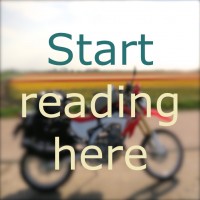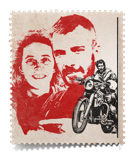FAQ
Before we left on the trip, we had hundreds of questions. About the paperwork, the gear, travel routes, vaccinations, tires, really about EVERYTHING. We visited a Horizons Unlimited Meeting and took notes during the workshops. We asked friends who had been on the road and read a lot of travel reports. The information from other travellers helped us enormously to prepare for the trip.
Now, after being on the road for more than two years, want to help future adventurers to prepare for their trip. We have received a lot of questions and are happy to answer all of those, hoping we can inspire more people to go on a trip. It can be our way of ‘paying it forward’
Preparation
How long did you prepare the trip? Five years. After three years we had enough money to leave, but due to family circumstances we postponed the trip. Two years later we left after all, which is a total preparation time of five years.
Finances
What is your budget? €50 per day for the two of us. This includes fuel, food and drinks, sleeping and daily expenses. Large expenses such as a new camera or shipping the bikes are not included.
Can you stay within this budget? Yes, the way we travel (a lot of camping, cooking ourselves, eating cheap, economical motorbikes, and not too many tourist trips), we can travel on €50 per day. In some countries, such as Bolivia, it was easy that stay below this budget. In the US $50 was not nearly enough. On balance, the cheaper countries help us to survive the more expensive countries.
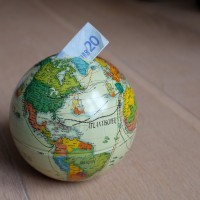 How long did you save money? Five years, the last two years a lot. We both had good jobs and put one salary into a savings account each month.
How long did you save money? Five years, the last two years a lot. We both had good jobs and put one salary into a savings account each month.
How did you save? By consciously choosing on which we spend our money. In our case this means: not eating out or only to cheap places, shoes to the shoemaker rather than a new pair, buying what is on sale, selling unnecessary stuff, but mainly by not spending money at all. Except for the stuff we needed for the trip.
Are you sponsored? No
Do you work while travelling? No. Keeping the website updated and maintaining the motorbikes sometimes feels like work, but that of course does not count.
Did you ever have to pay bribes? No. (At least, not that we know of)
Can you get money from an ATM everywhere? Yes, but not with all bank cards. So far we could always use our VISA card to get money. In many places Mastercard or an ordinary debit card would also work, but not everywhere, so we advise people to take a VISA card. The alternative is to bring US dollars to exchange for local currency. We have never exchanged Euros.
Paperwork
 Do you have second passport? No. In Amsterdam we could not get a second passport. We do have an extra thick passport.
Do you have second passport? No. In Amsterdam we could not get a second passport. We do have an extra thick passport.
Did you arrange the visas in advance? Only the Libyan visa. All the other visas, we applied for while we were on the road. Usually in the country before the country were we needed the visa: in Egypt for Sudan, in Sudan for Ethiopia, etc. In South- and Central America, we did not need visas. We would just get 90 days to visit the country by means of visa on arrival. For Asia, we will have to apply for some visas beforehand. We do that while we are on the road.
Do you have a Carnet de Passage? Yes. We used a carnet de passage for Africa. In the ‘Americas’ we did not need a carnet. We have a follow-up carnet for the trip from Asia to home.
Is a Carnet de Passage difficult to use? No, on the contrary! Travelling with a carnet de passage makes crossing borders a lot easier. It comes down to a simple fill-in exercise and a few stamps. And if the customs officer does not understand the carnet, you can always help them. 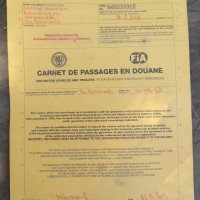 In South- and Central America all border crossings take a lot longer, because at each border you have to give all the information of the motorbikes, which takes a lot of time. This information is already mentioned in the carnet.
In South- and Central America all border crossings take a lot longer, because at each border you have to give all the information of the motorbikes, which takes a lot of time. This information is already mentioned in the carnet.
Is a Carnet de Passage expensive? Yes and no. We applied for the carnet in Germany at the ADAC. There, applying for a carnet costs €198 (if you are a member of an auto mobile association) and €10 for postage. In addition you have to pay a deposit. The amount of the deposit is based on the value of your bike. We had to pay €3000 per motorbike. The ADAC will repay the full deposit if you bring the bikes back home and you hand in your carnet. The only downside is that you cannot use this money in the meantime.
Do you have an international driving license? Yes, but we have never needed it in Africa or the Americas. It is only valid for one year, so it remains to be seen how we are going to solve this in Asia.
Do you have international bike registration? No (does that exist?)
 What insurance do you have for the motorbikes? We have not insured the motorbikes for theft, but only have third party liability insurance. In Europe our ’Green Card’ was valid. In most countries where you have to have third party insurance, you can buy it at the border or in the next town. For East Africa, we had a ’Comesa Yellow Card’, which was valid in a great number of countries. In Southern Africa is the insurance in included in the price you pay for fuel.
What insurance do you have for the motorbikes? We have not insured the motorbikes for theft, but only have third party liability insurance. In Europe our ’Green Card’ was valid. In most countries where you have to have third party insurance, you can buy it at the border or in the next town. For East Africa, we had a ’Comesa Yellow Card’, which was valid in a great number of countries. In Southern Africa is the insurance in included in the price you pay for fuel.
What insurance do you have for yourselves? We still have medical insurance in the Netherlands. On top of that, we have taken out a special insurance world people travelling around the world: Isis Special of Goudse Verzekeringen in the Netherlands. It covers additional medical expenses, luggage, etc. This was the only insurance that allowed us to stay insured more than two years. Costs are € 1,200 per year for the both of us.
Medical
 Which vaccinations do you have? Hepatitis A, Hepatitis B, Diphtheria, Tetanus, Polio, Yellow Fever, Typhoid, Rabius, Japanese Ensyfilitus and meningococcal.
Which vaccinations do you have? Hepatitis A, Hepatitis B, Diphtheria, Tetanus, Polio, Yellow Fever, Typhoid, Rabius, Japanese Ensyfilitus and meningococcal.
Do you use malaria medication? Not any more. We left Amsterdam with a bit box with two types of pills: Malerone and Lariam. We have taken the pills almost the entire trip in Africa (over eight months). Especially Leonie got many side effects (depression, hair loss). In South and Central America, we stopped taking the medication to prevent malaria, but now carry Malerone with us as medication for when we get Malaria. We also have two malaria test kits. (Note: this is not medical advice!)
Can you buy sanitary napkins everywhere? Yes, you can. Tampons can sometimes only be found in the larger supermarkets in the cities, but sanitary napkins you will find everywhere. It might not be your trusted brand, but usually well known ones.
Can you buy birth control pills everywhere? Yes, you can. There are pharmacies everywhere that sell medication, especially in bigger cities. You will be able to find all sorts of medication and will even be able to buy it over the counter in many cases. Just check the expiry date on the package.
Have you been sick? Yes. In Bolivia we both had stomach problems after we had eaten something bad. Peter once had a strange fever, which might have been dengue. Leonie had to have surgery in Ecuador on an inflamed haemorrhoid.
Motorbikes
Why did you choose the Honda CRF250L? We wanted a light, reliable, travel motorbike (lighter than the Honda Africa Twin and the Honda Transalp we had). 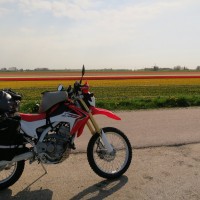 This was the only suitable option we could buy in the Netherlands because the CRF250L: is light, has a long service interval, is economic on fuel, has a steel subframe, was for sale new and has a Honda engine.
This was the only suitable option we could buy in the Netherlands because the CRF250L: is light, has a long service interval, is economic on fuel, has a steel subframe, was for sale new and has a Honda engine.
250cc, is that enough? Yes, the way we travel, where we try to avoid the highway and ride as many small roads, 250cc is fine. If a 400cc motorbike would exist that would have the same qualities as the CRF250L, it would have been interesting.
How are the bikes on the highway? We do not ride so many highways, because we do not like it. If we do ride on the highway, the maximum speed with luggage is about 110 km/h, but it is not comfortable without windshield and also asks a lot of the engine. A comfortable speed on the highway is 85 to 90 km/h.
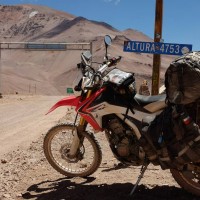 How are the bikes on high altitude? Pretty good. They loose a fair bit of their power, but the engine keeps running very smoothly.
How are the bikes on high altitude? Pretty good. They loose a fair bit of their power, but the engine keeps running very smoothly.
Do you miss the power of the Honda Africa Twin and the Honda Transalp? Only on the highway and in very deep sand.
How much do the motorbikes cost? € 4500 per motorbike (price from November 2012)
How much did the modifications cost? About € 2500 per motorbike
Were all modifications necessary? No, the most important were the shock, the larger tank and the luggage rack.
Would you choose a Honda CRF250L for your next trip? Yes, unless a suitable 400cc light travel motorbike would come on the market.
How much gas do you carry and what is your range with that? 20.5 liters per motorbike. There is 12 liters in the after-market IMS tank, 6.5 liters in the Rotopax jerrycan and two liters in a smaller jerrycan. Depending on the terrain the motorbikes do 1/25 to 1/30, so that gives us at least 500 km and in the best case, even 600 km.
Do the motorbikes use oil? No. Peter’s bike uses a bit of oil, Leonie’s motorbike none.
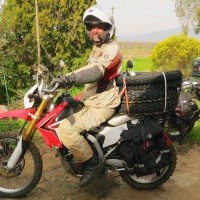 Do you carry spare tires? No. That is too heavy and takes up too much space. We buy tires while we are on the road..
Do you carry spare tires? No. That is too heavy and takes up too much space. We buy tires while we are on the road..
Can you get tires for you motorbikes everywhere? Yes. In almost all countries we could get tires. Maybe not always the brand we want and slightly more expensive than at home, but in the end we always find suitable tires. We have changed our tires in South Africa, Chile, Ecuador, Guatemala and Canada. We’ve never ordered tires upfront.
How do you do maintenance on the motorbikes? Peter does all the maintenance on the motorbikes himself. Both the regular maintenance such as changing oil and adjusting the chain, as the slightly bigger jobs as adjusting the valves and changing tires. He is not trained as a mechanic but autodidact. There’s really a lot on YouTube 
What problems did you have with the bikes? None on Leonie’s bike and some minor issues on Peter’s bike. His bike uses a bit of oil, had a problem with the piston band of one of the front forks and needed a new automatic chain tensioner as the previous one failed. This is apart from regular maintenance on the bike and the after-market Hyperpro shocks.
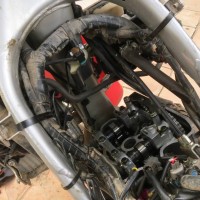 Do you carry spare parts? Yes. We carry the spares for the parts that have to be replaced during regular maintenance, such as small sprockets, oil filters and brake pads. We also carry parts of which we know they can break on the CRF250L. The heavier components, such as the rear sprocket, the chain and the tires we buy on the road.
Do you carry spare parts? Yes. We carry the spares for the parts that have to be replaced during regular maintenance, such as small sprockets, oil filters and brake pads. We also carry parts of which we know they can break on the CRF250L. The heavier components, such as the rear sprocket, the chain and the tires we buy on the road.
Do you carry tools with you? Yes. We have the tools that Peter needs to do the regular maintenance and the most common jobs on the bikes. We only carry tools that fit on our bikes.
How many punctures have you had? One!
Do you advise hard or soft luggage? Soft luggage. We used aluminium panniers on our previous motorbikes (Touratech Zega) and now have soft luggage (Magadan Panniers of Adventure Spec). We are very happy with our soft luggage, which we can best explain by comparing them to our aluminium panniers. Soft bags are lighter than aluminium panniers. The bags are tightly fixed on the bikes, but still very flexible, in the sense that they can move around a bit. The first advantage is that the gear inside the bags does not vibrate, whereas with our aluminium panniers gear would break due to vibration. Also when you fall, the flexibility of the bags makes that the force of the fall in somehow spread. 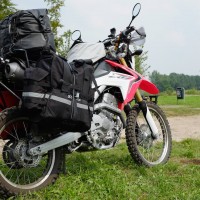 Out of all the times we fell, our racks have not bent, our bags have not torn and only two plastic containers have broken. When we fell on our aluminium panniers it happened that the panniers got dented and were not longer waterproof. We heard of other travellers where the panniers broke off completely. Another advantage is that the times we fell where our foot got stuck under the soft bag (by paddling or falling) we only had a slightly bruised foot, but never broke any bones.
Out of all the times we fell, our racks have not bent, our bags have not torn and only two plastic containers have broken. When we fell on our aluminium panniers it happened that the panniers got dented and were not longer waterproof. We heard of other travellers where the panniers broke off completely. Another advantage is that the times we fell where our foot got stuck under the soft bag (by paddling or falling) we only had a slightly bruised foot, but never broke any bones.
A frequently heard complaint about soft luggage is a risk of theft. Our bags are lined with Kevlar, making it very hard (to impossible) to cut them open with a knife. We have a steel cable with a lock around the bags to demotivate thieves to try to open them. Until now during our two years of travelling with the soft luggage, no one has ever tried to steal something from the inside of the bags. It takes a bit getting used to, but it is easier to pack them. The bags are water-resistant and have removable waterproof inner bags. The only disadvantage is that we cannot use them as chairs:)
How much luggage do you carry? About 35kg, distributed over a tank bag, a duffel bag and two side bags. There are times when we take a lot more stuff and extra spare parts, so we temporarily ride with more luggage (even up to 50kg!) But ideally we ride with 35kg.
On the road
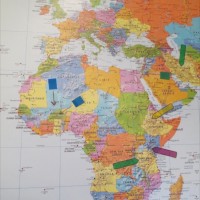 How did you come up with this route around the world? We wanted to leave home riding our bikes, first go to Africa, and after the trip also arrive back home riding our bikes. For the rest of the route we looked at where we wanted to go (which countries, which sights, which routes) and then to the weather (rainy season or winter).
How did you come up with this route around the world? We wanted to leave home riding our bikes, first go to Africa, and after the trip also arrive back home riding our bikes. For the rest of the route we looked at where we wanted to go (which countries, which sights, which routes) and then to the weather (rainy season or winter).
Do you make a route every day? No. We listen to tips of other travellers and decide from day to day whether we will ride and where we will go.
What was it like to drive through Libya and Sudan? Great! We had just started our trip and were surprised by the overwhelming hospitality in North Africa and Libya in particular. We have only visited Sudan (not South Sudan, which is still in state of war) and have felt very safe and welcome.
Can you camp everywhere? Yes, in Africa you can find campsite almost everywhere and there are plenty of places to bush camp. In South America we have both camped and stayed in hostels, either because there were no campgrounds or because of the weather.
Do you cook yourselves? Yes, we carry cooking equipment. From Bolivia to Mexico we ate out at least once a day at a local restaurant or on the street, because it was very good food and above all very cheap.
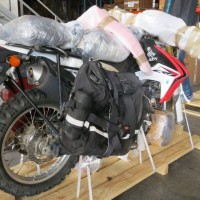 How did you take the motorbikes to South America? By plane. That happened with a cargo flight and not in the same plane as we were in.
How did you take the motorbikes to South America? By plane. That happened with a cargo flight and not in the same plane as we were in.
Is it expensive to fly your bike? From Johannesburg in South Africa to Buenos Aires in Argentina we paid €2,500 for two motorbikes (including all the paperwork, the crate and other service of our agent)
What was it like to import the motorbikes in Buenos Aires? Very expensive! We do not recommend to ship vehicles to be imported to Argentina. It is much cheaper and quicker to ship to Chile!
Communication
What headset do you use? Sena SMH10
 Do you have internet everywhere? Yes! It might not be as fast everywhere, but we can get online everywhere. We buy a local SIM card in each country and always have mobile Internet. Particularly in Africa, this was surprisingly fast. Sometimes we have a few days without the Internet, but other days it is faster than we had at home in the Netherlands.
Do you have internet everywhere? Yes! It might not be as fast everywhere, but we can get online everywhere. We buy a local SIM card in each country and always have mobile Internet. Particularly in Africa, this was surprisingly fast. Sometimes we have a few days without the Internet, but other days it is faster than we had at home in the Netherlands.
Do you have a satellite phone? No
Are you using a SPOT? No
How did you make the website? With wordpress
Do you have a lot of work on the website? Yes, a lot of work. If you do not want to write all the time, consider starting a Facebook account for the trip where you can post mainly pictures
How do you translate the stories? I translate the Dutch stories with Google Translate to English and edit the translation afterwards.
Camping gear
What stove do you use? The Primus Omnifuel and we use gasoline for cooking. Very handy as we always carry it with us. We are very happy with the stove and would recommend it. Main strengths are that it can also burn slowly and the metal pump in the stove does not break (as opposed to a plastic pump).
 Where do you store the stove? The fuel bottle with the pump is in a back pocket on the outside of one of the bags. The windshield is wrapped around the fuel bottle. The stove we keep inside one of the bags.
Where do you store the stove? The fuel bottle with the pump is in a back pocket on the outside of one of the bags. The windshield is wrapped around the fuel bottle. The stove we keep inside one of the bags.
Which tent do you have? We have the Mutha Hubba NX, a three-person tent of MSR. We left home with the old version of the Mutha Hubba tent, which was perfect. Unfortunately, we had to replace that tent. We opted for the new Mutha Hubba NX, but are not so happy with that tent. The design of the tent is not optimal as a result of which the outer fly touches the inner tent, especially with heavy rain and strong wind.
Personal
Are you ever homesick? Leonie: Yes, sometimes. Especially on special days such as birthdays and holidays. And if I know that someone back home could use a hug. Sometimes I would just like to drink a glass of wine with friends or a coffee with my sister and my nephew.
Peter: No, never.
Are you not tired of travelling? No! (Unanimous this time)
Is it not hard to travel around the world for so long? The most difficult part of the whole trip is the decision to go. Once you made that decision and you go, there is a weight lifted of your shoulders and you just go. And of course, sometimes there are difficult times on the road. Though we have very little of those tough days 
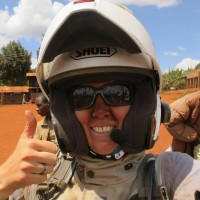 What was your favourite country? It’s hard to name a single country. We found Uganda, Rwanda and Colombia surprising, the people of Malawi lovely and nature in Namibia and Chile beautiful. We often advise people to go to Uganda or Colombia during their next vacation.
What was your favourite country? It’s hard to name a single country. We found Uganda, Rwanda and Colombia surprising, the people of Malawi lovely and nature in Namibia and Chile beautiful. We often advise people to go to Uganda or Colombia during their next vacation.
Have you had any problems along the way? No. We encountered one nasty police officer in Sudan and one horrible customs officer in Zimbabwe. Once Peter was almost pick pocketed in Ethiopia, but he found out in time. Once in Nicaragua we caught a guy who was trying to steal our cutlery, but we chased him. In Mexico, a thermos bottle was stolen from a bag on the outside of our panniers. If that’s all … ..
Are you ever afraid? Leonie: No, not really. I’m afraid of heights and do not like frogs, snakes and horror movies, so I’m “afraid” of those. Throughout the journey I’ve only felt unsafe once, when we arrived from Zimbabwe in South Africa and along the side of the road were signs that read: “Do NOT stop. High crime area.”
Peter: No.
Do you carry a weapon? No! Well, only our catapult to chase away thieving monkeys. We also have never felt that we needed a weapon.
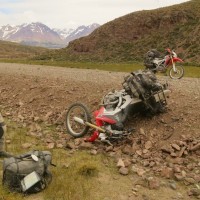 Do you ever fall with the motorbikes? Yes, we have both fallen a number of times. Aside from some scratches on the bikes and a dent in the ego, nothing serious.
Do you ever fall with the motorbikes? Yes, we have both fallen a number of times. Aside from some scratches on the bikes and a dent in the ego, nothing serious.
Is not it dangerous to travel as a woman? No, I do not experience it that way. I have to say that I’m almost never alone. I did notice that people sometimes approach me differently than Peter. In North Africa, men walked past me to start a conversation with Peter. But that also happened in South America, if someone wanted to know something about the motorbikes. These are cultural differences that I had to get used to, but does not make the trip unsafe for me.
What might help is that I have adapted as much as possible to the culture. For example, I have not worn no shorts or short sleeves on the streets in Northern Africa.
We sometimes have the idea that it actually helps that I am a woman, especially when we have to deal with police officers or border officials. So occasionally we try to use it to our advantage:).
What is it like to travel as a couple? Usually great, sometimes a challenge. The main thing is that we feel very lucky that we both love to to travel around the world like we do. We are pleased to share those experiences with each other. At the same time, it is sometimes quite difficult. We are 365 days of the year, 24 hours a day together and spend a lot of time in a tent of only 6 m2. Here you cannot slam the door behind you if you need some space. Annoyances that will probably only emerge after a few years at home, now come to the surface a lot sooner. We think that two years traveling equals at least ten years of living together.
 Did you ever regret the decision to go? No, not for a second! It was the best decision we have ever taken together and we would take the same decision tomorrow.
Did you ever regret the decision to go? No, not for a second! It was the best decision we have ever taken together and we would take the same decision tomorrow.
Did you take a sabbatical? No, we both quit our jobs.
Are not you afraid that you will not find a job when you get back? No. We may not immediately find our dream job, but there is always a job we can do, even at a waiter or a mailman.
Are not you afraid that you will never get used to normal life again? Sometimes. The way we travel, it is almost like a lifestyle, which is a bit addictive. We heard from other travelers who have now returned home, that they miss traveling immensely. Not only because they have to work again, but also because the days are the same and are all spent in the same place. Traveling has definitely changed us so far, but we also have dreams for after the trip. Besides, we have to make money, even if we want to travel further. We will see.
Other questions
Is your question not listed? Or do you have a question about one of the answers? Send us an email and we’ll try to answer your question.
peter@amsterdamtoanywhere.nl or leonie@amsterdamtoanywhere.nl
Last updated 15-11-2015
Newsletter
Subscribe for the email service and automatically receive a notification for each new post!
[subscribe2]















